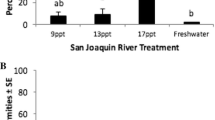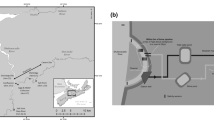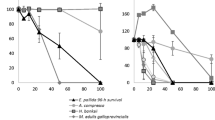Abstract
Currently, several desalination facilities have been proposed to operate or are actually operating in California. These facilities’ use of reverse osmosis (RO) may discharge hypersaline reject brine into the marine environment. The risks, if any, this brine would pose to coastal receiving waters are unknown. To test the toxicity of hypersaline brine in the absence of any additional toxic constituents, we prepared brine and tested it with the seven toxicity test organisms listed in the 2009 California Ocean Plan. The most sensitive protocols were the marine larval development tests, whereas the most tolerant to increased salinities were the euryhaline topsmelt, mysid shrimp, and giant kelp tests. Reject brines from the Monterey Bay Aquarium’s RO desalination facility were also tested with three species. The effects of the aquarium’s brine effluent on topsmelt, mussels, and giant kelp were consistent with those observed in the salinity tolerance experiments. This information will be used by regulators to establish receiving water limitations for hypersaline discharges.

Similar content being viewed by others
References
Bailey HC, Miller JL, Miller MJ, Dhaliwal BS (1995) Application of toxicity identification procedures to the echinoderm fertilization assay to identify toxicity in a municipal effluent. Environ Toxicol Chem 14:2181–2186
Bay SM, Greenstein D (1994) Toxic effects of increased salinity and desalination waste brine. In: Cross JN, Francisco C, Hallock D (eds) Southern California coastal water research project 1992–93 annual report. Southern California coastal water research project. Westminster, CA, pp 149–153
Conroy PT, Hunt JW, Anderson BA (1996) Validation of short-term toxicity test endpoint by comparison with longer-term effects on larval red abalone Haliotis rufescens. Environ Toxicol Chem 15:1245–1250
Dinnel PA, Link JM, Stober QJ, Letourneau MW, Roberts WE (1989) Comparative sensitivity of sea urchin sperm bioassays to metals and pesticides. Arch Environ Contam Toxicol 18:748–755
Hunt JW, Anderson BS (1989) Sublethal effects of zinc and municipal effluents on larvae of the red abalone Haliotis rufescens. Marine Biol 101:545–552
Hunt JW, Anderson BS, Phillips BM, Tjeerdema RS, Puckett HM, Stephenson M et al (2002) Acute and chronic toxicity of nickel to marine organisms: Implications for water quality criteria. Environ Toxicol Chem 21:2423–2430
Jenkins S, Paduan J, Roberts P, Schlenk D, Weis J (2012) Management of brine discharges to coastal waters—Recommendations of a Science Advisory Panel. Southern California coastal water research project. Costa Mesa, CA
Lussier SM, Gentile JH, Walker J (1985) Acute and chronic effects of heavy metals and cyanide on Mysidopsis bahia (Crustacea: Mysidacea). Aquat Toxicol 7:25–35
Matsumoto JK, Martin KLM (2008) Lethal and sublethal effects of altered sand salinity on embryos of beach-spawning California grunion. Copeia 2:484–491
Pillard DA, DuFresne DL, Tietge JE, Evans JM (1999) Response of mysid shrimp (Mysidopsis bahia), sheepshead minnow (Cyprinodon variegatus), and inland silverside minnow (Menidia beryllina) to changes in artificial seawater salinity. Environ Toxicol Chem 18:430–435
Sprague JB (1985) Factors that modify toxicity. In: Rand GM, Petrocelli SR (eds) Fundamentals of aquatic toxicology. Hemisphere Publishing, Washington, pp 124–163
State water resources control board (2009) Water quality control plan for ocean waters of California—California ocean plan. SWRCB, Sacramento
United States Environmental Protection Agency (1995) Short-term methods for estimating the chronic toxicity of effluents and receiving waters to West Coast marine and estuarine organisms. EPA/600/R-95/136. Office of Research and Development, Washington DC, USA
United States Environmental Protection Agency (2002) Short-term methods for estimating the chronic toxicity of effluents and receiving waters to marine and estuarine organisms. EPA-821-R-02-014. Office of Water, Washington DC, USA
Weston Solutions, Inc., (2007) 96 hour acute effluent toxicity bioassay. Technical report. Weston Solutions, Inc., Carlsbad, CA pp 1–6
Acknowledgments
This study was funded by the California State Water Resources Control Board.
Author information
Authors and Affiliations
Corresponding author
Rights and permissions
About this article
Cite this article
Voorhees, J.P., Phillips, B.M., Anderson, B.S. et al. Hypersalinity Toxicity Thresholds for Nine California Ocean Plan Toxicity Test Protocols. Arch Environ Contam Toxicol 65, 665–670 (2013). https://doi.org/10.1007/s00244-013-9931-3
Received:
Accepted:
Published:
Issue Date:
DOI: https://doi.org/10.1007/s00244-013-9931-3




